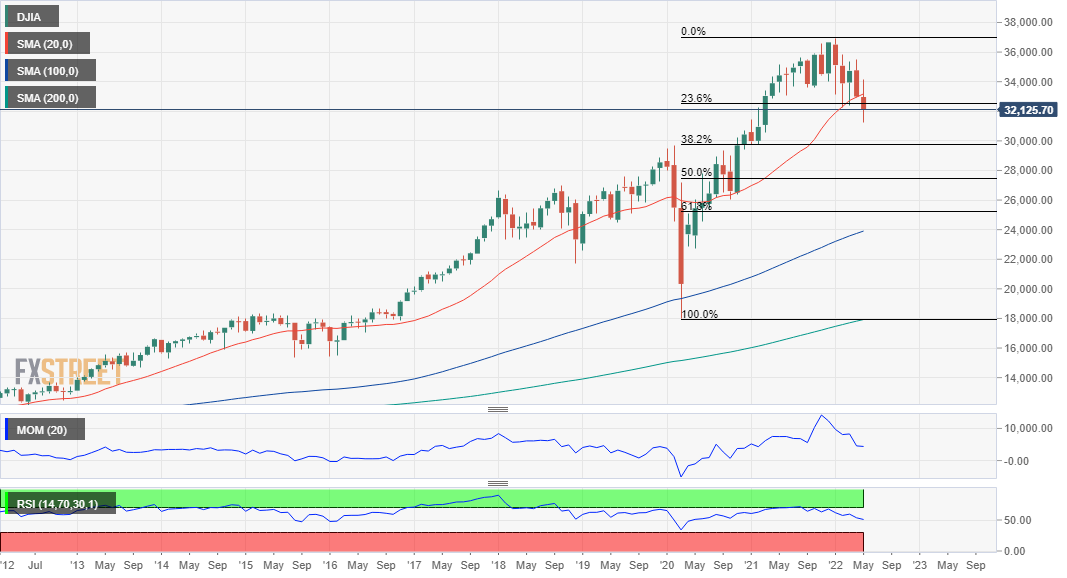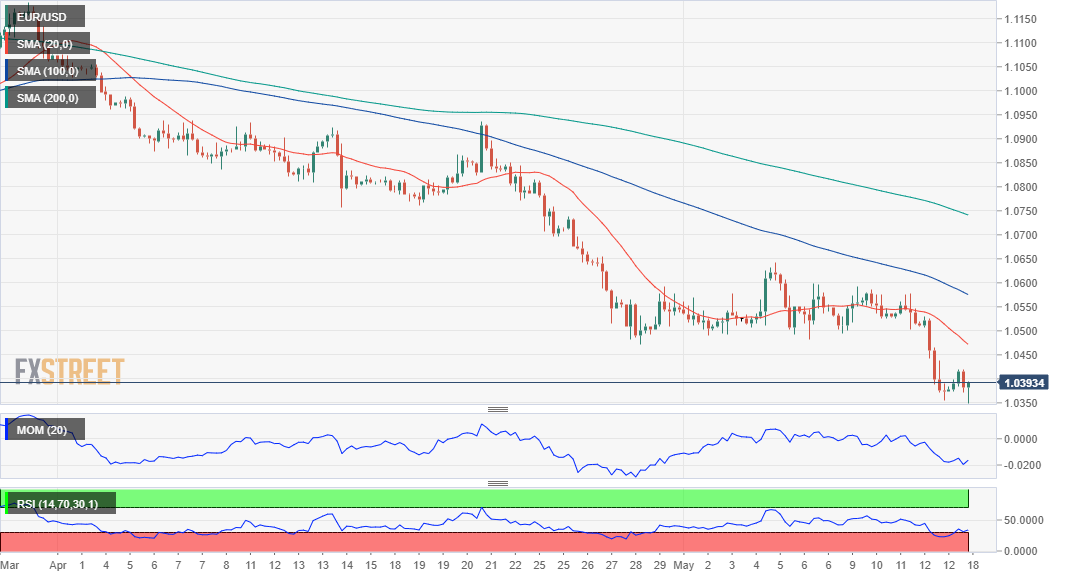- Out-of-control inflation, slowing growth, and Russia combined to put markets in panic mode.
- Central bankers from around the world are mounting the tightening path.
- EUR/USD is extremely oversold in the long term, but it still has room to fall.
The EUR/USD pair finally left its consolidative phase, breaking lower and falling to a multi-year low of 1.0348. It closed the week a handful of pips above the level, with sellers now adding shorts on spikes beyond the 1.0400 figure.
The perfect storm
The collapse took place on Thursday, following the release of US inflation figures the day before. The Consumer Price Index rose by 8.3% YoY in April, above the market’s forecast of 8.1%. The core reading hit 6.2%, also higher than the 6% expected, reflecting broad-based inflationary pressures that would be hard to tame.
Also, more and more central bankers from around the world joined the tightening train. Multiple European Central Bank officials stated that they would be comfortable hiking rates right after finishing the massive bond-buying program known as APP in July. Across the pond, US Federal Reserve chief Jerome Powell repeated that the central bank is likely to raise rates by 50 bps in its next two meetings.
The Fed is two steps ahead of its major counterparts, but several central banks are running before the Fed and also announcing upcoming tighter monetary policies. The only exception is the Bank of Japan, as Governor Haruhiko Kuroda said they would maintain their dovish guidance and not hesitate to take additional easing steps.
Finally, tensions between Russia and western nations fueled the risk-averse mood. Finland has announced it would drop its neutral stance and apply to join NATO, while Sweden is considering a similar move. Moscow threatened to retaliate if Finland joins the organization.
Russian Deputy Chairman Dmitry Medvedev warned that military assistance for Ukraine risks creating a conflict between Russia and NATO. Meanwhile, Ukraine has announced it would suspend Gazprom gas transit on its territory. European Commission President Ursula von der Leyen said Russia was the “most direct threat” to the international order.
Market’s implications
So, we have out of control inflation, slowing growth, and central banks draining massive liquidity introduced to cope with the pandemic. By the way, it is worth noting that the latter is not yet over, and cases are back on the rise, anticipating a new wave and triggering measures that would add to the global burden.
It seems logical that speculative interest began retreating, particularly from high-yielding, volatile assets such as equities and cryptos. And in fact, stocks´ decline seems a mere correction. Take a look at this Dow Jones Industrial Average monthly chart:

The index is currently hovering around the 23.6% retracement of its March 2020/January 2022 rally. Even further, if we take out the early 2020 decline triggered by the pandemic, the index has been rallying since March 2009. The DJIA needs to shed 2,000 points more to reach the 23.6% retracement of the 2009/2022 run. It would need to lose 5,000 points more to pierce the 38.2% retracement and actually be at risk of entering a long-term bearish market.
The greenback is largely overbought in the near term, and a corrective decline is not on the table. Nevertheless, the overall scenario favors the continued dollar’s strength.
Investors’ confidence on the back foot
Data released these days showed that sentiment plunged. The May EU Sentix Investor Confidence fell to -22.5, while the German ZEW Survey for the same month offered a similar picture, noting that the economic setback will likely continue. Also, the US preliminary May Michigan Consumer Sentiment Index plunged to 59.1, its lowest in over a decade.
Regarding inflation, Germany confirmed the annual CPI at 7.8% YoY in April. The EU Producer Price Index rose to 11% YoY in the same month, both signaling that overheating prices are not exclusive to the US.
During the upcoming week, the focus will be on the EU's second estimate of the Q1 Gross Domestic Product, foreseen at 0.2% QoQ, while the US will publish April Retail Sales, expected to have risen by 0.7% MoM.

EUR/USD technical outlook
The EUR/USD pair is extremely oversold after falling for six consecutive weeks. Technical readings in the wider perspective reflect a strong bearish momentum that would likely favor additional declines in the upcoming weeks. Nevertheless, a corrective advance or at least another consolidative phase is on the cards and would help to enhance the dominant trend.
The daily chart shows that the pair is developing well below firmly bearish moving averages, in line with the latest collapse. However, technical indicators have begun giving signs of bearish exhaustion. The RSI indicator is now flat at around 26, while the Momentum indicator aims marginally higher from a multi-week low.
The main bearish target and the immediate support level is 1.0339, the low from January 2017. The pair bottomed at 1.0334 in January 2003, reinforcing the level’s strength and making more relevant a potential breakout. Once below the latter should see the pair approaching the 1.0200 figure, and traders start jawboning about parity.
A relevant resistance level comes at 1.0470, the former 2022 low. A recovery beyond it could see the pair extending its corrective advance towards the 1.0600 region, where sellers will likely resurge.
EUR/USD sentiment poll
The FXStreet Forecast Poll hints at another leg lower before a bullish correction. 70% of the polled experts expect EUR/USD to extend its decline next week with the pair seen on average at 1.0380. However, bears decrease to just 17% in the monthly view, while bulls jump to 83%, with the pair expected to recover towards the 1.0600 region. A few experts see it as high as 1.1000, although the percentage is small. In the quarterly perspective, bulls are still a majority, but the pair is still seen stuck at 1.0600.
The Overview chart shows that the three moving averages maintain their firmly bearish slopes. The potential targets’ range is quite limited in the weekly and monthly perspectives but widens in the longer view to 1.00/1.12. Still, the largest accumulation of possible targets is below the 1.0600 figure, in line with the dominant bearish trend.

Information on these pages contains forward-looking statements that involve risks and uncertainties. Markets and instruments profiled on this page are for informational purposes only and should not in any way come across as a recommendation to buy or sell in these assets. You should do your own thorough research before making any investment decisions. FXStreet does not in any way guarantee that this information is free from mistakes, errors, or material misstatements. It also does not guarantee that this information is of a timely nature. Investing in Open Markets involves a great deal of risk, including the loss of all or a portion of your investment, as well as emotional distress. All risks, losses and costs associated with investing, including total loss of principal, are your responsibility. The views and opinions expressed in this article are those of the authors and do not necessarily reflect the official policy or position of FXStreet nor its advertisers. The author will not be held responsible for information that is found at the end of links posted on this page.
If not otherwise explicitly mentioned in the body of the article, at the time of writing, the author has no position in any stock mentioned in this article and no business relationship with any company mentioned. The author has not received compensation for writing this article, other than from FXStreet.
FXStreet and the author do not provide personalized recommendations. The author makes no representations as to the accuracy, completeness, or suitability of this information. FXStreet and the author will not be liable for any errors, omissions or any losses, injuries or damages arising from this information and its display or use. Errors and omissions excepted.
The author and FXStreet are not registered investment advisors and nothing in this article is intended to be investment advice.
Recommended Content
Editors’ Picks

Gold gives away some gains, slips back to $2,980
Gold retraced from its earlier all-time highs above the key $3,000 mark on Friday, finding a footing around $2,980 per troy ounce. Profit-taking, rising US yields, and a shift to a risk-on environment seem to be putting the brakes on further gains for the metal.

EUR/USD remains firm and near the 1.0900 barrier
EUR/USD is finding its footing and trading comfortably in positive territory as the week wraps up, shaking off two consecutive daily pullbacks and setting its sights back on the pivotal 1.0900 mark—and beyond.

GBP/USD remains depressed, treads water in the low-1.2900s
GBP/USD is holding steady in consolidation territory after Friday’s opening bell on Wall Street, hovering in the low-1.2900 range. This resilience comes despite disappointing UK data and persistent selling pressure on the USD.

Crypto Today: BNB, OKB, BGB tokens rally as BTC, Shiba Inu and Chainlink lead market rebound
Cryptocurrencies sector rose by 0.13% in early European trading on Friday, adding $352 million in aggregate valuation. With BNB, OKB and BGB attracting demand amid intense market volatility, the exchange-based native tokens sector added $1.9 billion.

Week ahead – Central banks in focus amid trade war turmoil
Fed decides on policy amid recession fears. Yen traders lock gaze on BoJ for hike signals. SNB seen cutting interest rates by another 25bps. BoE to stand pat after February’s dovish cut.

The Best brokers to trade EUR/USD
SPONSORED Discover the top brokers for trading EUR/USD in 2025. Our list features brokers with competitive spreads, fast execution, and powerful platforms. Whether you're a beginner or an expert, find the right partner to navigate the dynamic Forex market.
